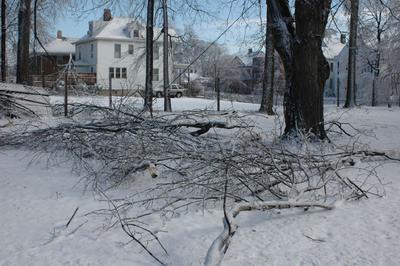Snow and Woody Plants
Editor's Note: This article informs homeowners of the benefits and possible damage caused to trees by snow. Tree care companies: Don't forget to share this with your customers!
 “Snow is both friend and foe to trees and shrubs,” says Tchukki Andersen, BCMA, CTSP*, and staff arborist with the Tree Care Industry Association (TCIA). “Snow causes its share of damage, as we all know, but in many cases it also protects plants and their roots from extreme fluctuations in temperature that could damage or even kill them.”
“Snow is both friend and foe to trees and shrubs,” says Tchukki Andersen, BCMA, CTSP*, and staff arborist with the Tree Care Industry Association (TCIA). “Snow causes its share of damage, as we all know, but in many cases it also protects plants and their roots from extreme fluctuations in temperature that could damage or even kill them.”
Excess snow, however, can also damage trees and woody shrubs by bending, breaking and splitting, and causing them to fall or uproot. Whether woody plants will be damaged in one of these ways depends upon several factors. Coniferous evergreens, for instance, can bear more snow weight than broadleaf evergreens. A tree’s form can also determine how well it will withstand heavy snow. For example, pine (low altitude), spruce and fir trees with spread branches are more likely to be damaged by heavy snowfall than trees with steeper angled branches.
Arborvitae, evergreen shrubs with tall, narrow growth habits planted in hedges or as foundation screens, are a good example of a plant that doesn’t handle heavy snow well. They tend to grow tall, with multi-stemmed branches that are low to the ground.
“Snow will cause the branches to separate,” says Andersen, who doesn’t recommend planting arborvitae species in areas that get lots of heavy, wet snow. She also warns against planting them near buildings where snow accumulates on the roof, then falls in large piles. “Small, rounded woody-stemmed plants are a better choice, but make certain to give them enough root space away from the structure.”
A tree’s structure is also a factor in whether it will be damaged by ice storms. A tree with good, right-angle branches will have less trouble than one with narrow, more vertical branch crotches.
The type of snow is an important factor in potential damage to trees. Obviously, wet snow is more damaging because it is heavier. The time of season for snowfalls can also be a factor. With a wet snow in March, when there are no leaves on the branches, the tree may be able to withstand damage pretty well. But that same snow in late spring or early fall, when the tree is filled with leaves, could add unbearable weight.
On the plus side, snow moderates root temperatures and provides moisture for spring. Snow helps insulate the ground, which is beneficial for two reasons. First, snow is a poor heat conductor, so the temperature changes very slowly from the top layer of the snow to the bottom. This keeps the ground from heating and cooling as air temperatures fluctuate. Heating and cooling often cause the ground to heave, which can be damaging to roots. Keeping the ground temperature stable is more conducive to healthy roots.
“Finally, a little breakage isn’t always bad,” insists Andersen. “Nature prunes trees, too. Wet snow may break off small twigs and dead branches. It can do a good job of pruning that way. Just follow up with some cleaning cuts.”
If you’re dealing with damage to trees and shrubs, it may be time to call in an expert. A professional arborist can assess your trees and safely address any issues. Click here to search for professional tree care in your ZIP code.